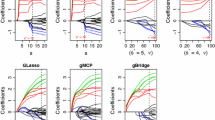Abstract
In practice, predictors possess grouping structures spontaneously. Incorporation of such useful information can improve statistical modeling and inference. In addition, the high-dimensionality often leads to the collinearity problem. The elastic net is an ideal method which is inclined to reflect a grouping effect. In this paper, we consider the problem of group selection and estimation in the sparse linear regression model in which predictors can be grouped. We investigate a group adaptive elastic-net and derive oracle inequalities and model consistency for the cases where group number is larger than the sample size. Oracle property is addressed for the case of the fixed group number. We revise the locally approximated coordinate descent algorithm to make our computation. Simulation and real data studies indicate that the group adaptive elastic-net is an alternative and competitive method for model selection of high-dimensional problems for the cases of group number being larger than the sample size.
Similar content being viewed by others
References
Bickel P J, Ritov Y, Tsybakov A B. Simultaneous analysis of LASSO and Dantzig selector. Ann Statist, 2009, 37: 1705–1732
Breheny P, Huang J. Penalized methods for bi-level variable selection. Stat Interface, 2009, 2: 369–380
Candès E, Tao T. Decoding by linear programming. IEEE Trans Inform Theory, 2005, 51: 4203–4215
Candès E, Tao T. The Dantzig selector: Statistical estimation when p is much larger than n. Ann Statist, 2007, 35: 2313–2351
Fan J, Li R. Variable selection via nonconcave penalized likelihood and its oracle properties. J Amer Statist Assoc, 2001, 96: 1348–1360
Friedman J, Hastie T, Tibshirani R. A note on the group LASSO and a sparse group LASSO. Techinical report. Stanford: Stanford University, 2010
Horvath S, Zhang B, Carlson M, et al. Analysis of oncogenic signaling networks in glioblastoma identifies aspm as a molecular target. Proc Natl Acad Sci USA, 2006, 103: 17402–17407
Huang J, Breheny P, Ma S. A selective review of group selection in high-dimensional models. Statist Sci, 2012, 27: 481–499
Huang J, Ma S, Xie H, et al. A group bridge approach for variable selection. Biometrika, 2009, 96: 339–355
Jiang D, Huang J. Concave 1-norm group selection. Biostatistics, 2015, 16: 252–267
Knight K, Fu W. Asymptotics for LASSO-type estimators. Ann Statist, 2000, 28: 1356–1378
Li R, Zhong W, Zhu L. Feature screening via distance correlation learning. J Amer Statist Assoc, 2012, 107: 1129–1139
Lounici K, Pontil M, Van De Geer S, et al. Oracle inequalities and optimal inference under group sparsity. Ann Statist, 2011, 39: 2164–2204
Simon N, Friedman J, Hastie T, et al. A sparse-group LASSO. J Comput Graph Statist, 2013, 22: 231–245
Tibshirani R. Regression shrinkage and selection via the LASSO. J R Stat Soc Ser B Stat Methodol, 1996, 58: 267–288
Vaart A V D. Asymptotic Statistics. Cambridge: Cambridge University Press, 1998
Yuan M, Lin Y. Model selection and estimation in regression with grouped variables. J R Stat Soc Ser B Stat Methodol, 2006, 68: 49–67
Zhang C-H. Nearly unbiased variable selection under minimax concave penalty. Ann Statist, 2010, 38: 894–942
Zou H. The adaptive LASSO and its oracle properties. J Amer Statist Assoc, 2006, 101: 1418–1429
Zou H, Hastie T. Regularization and variable selection via the elastic net. J R Stat Soc Ser B Stat Methodol, 2005, 67: 301–320
Zou H, Zhang H H. On the adaptive elastic-net with a diverging number of parameters. Ann Statist, 2009, 37: 1733–1751
Acknowledgements
This work was supported by National Natural Science Foundation of China (Grant No. 11571219) and the Open Research Fund Program of Key Laboratory of Mathematical Economics (SUFE) (Grant No. 201309KF02), Ministry of Education, and Changjiang Scholars and Innovative Research Team in University (Grant No. IRT13077). The authors thank anonymous referees for their constructive comments that lead to the current improved version.
Author information
Authors and Affiliations
Corresponding author
Rights and permissions
About this article
Cite this article
Hu, J., Huang, J. & Qiu, F. A group adaptive elastic-net approach for variable selection in high-dimensional linear regression. Sci. China Math. 61, 173–188 (2018). https://doi.org/10.1007/s11425-016-0071-x
Received:
Accepted:
Published:
Issue Date:
DOI: https://doi.org/10.1007/s11425-016-0071-x
Keywords
- high-dimensional regression
- group variable selection
- group adaptive elastic-net
- oracle inequalities
- oracle property




